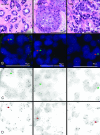Telomere length on chromosome 17q shortens more than global telomere length in the development of breast cancer
- PMID: 17460770
- PMCID: PMC1854852
- DOI: 10.1593/neo.07106
Telomere length on chromosome 17q shortens more than global telomere length in the development of breast cancer
Abstract
It is known that total telomere length is shorter in invasive breast cancer than in normal breast tissue but the status of individual telomere lengths has not been studied. Part of the difficulty is that usually telomere length in interphase cells is measured on all chromosomes together. In this study we compared normal breast epithelium, duct carcinoma in situ (DCIS), and invasive duct carcinoma (IDC) from 18 patients. Telomere length was specifically measured on chromosome 17q and was found to be shorter in DCIS and IDC than in normal breast epithelial cells, with more heterogeneity in telomere length in DCIS associated with IDC than in DCIS alone. More importantly, we found that the shortening of telomere on chromosome 17q is greater than the average shortening of all telomeres. This finding indicates that telomere shortening is not simply the result of the end replication problem; otherwise, all telomeres should be subjected to the same rate of telomere shortening. It seems there are mechanisms that preferentially erode some telomeres more than others or preferentially protect some chromosome ends. Our results suggest that the increased level of telomere shortening on 17q may be involved in chromosome instability and the progression of DCIS.
Figures



References
-
- Cong YS, Bacchetti S. Histone deacetylation is involved in the transcriptional repression of hTERT in normal human cells. J Biol Chem. 2000;275:35665–35668. - PubMed
-
- Cong YS, Wen J, Bacchetti S. The human telomerase catalytic subunit hTERT: organization of the gene and characterization of the promoter. Hum Mol Genet. 1999;8:137–142. - PubMed
Publication types
MeSH terms
LinkOut - more resources
Full Text Sources
Other Literature Sources
Medical
